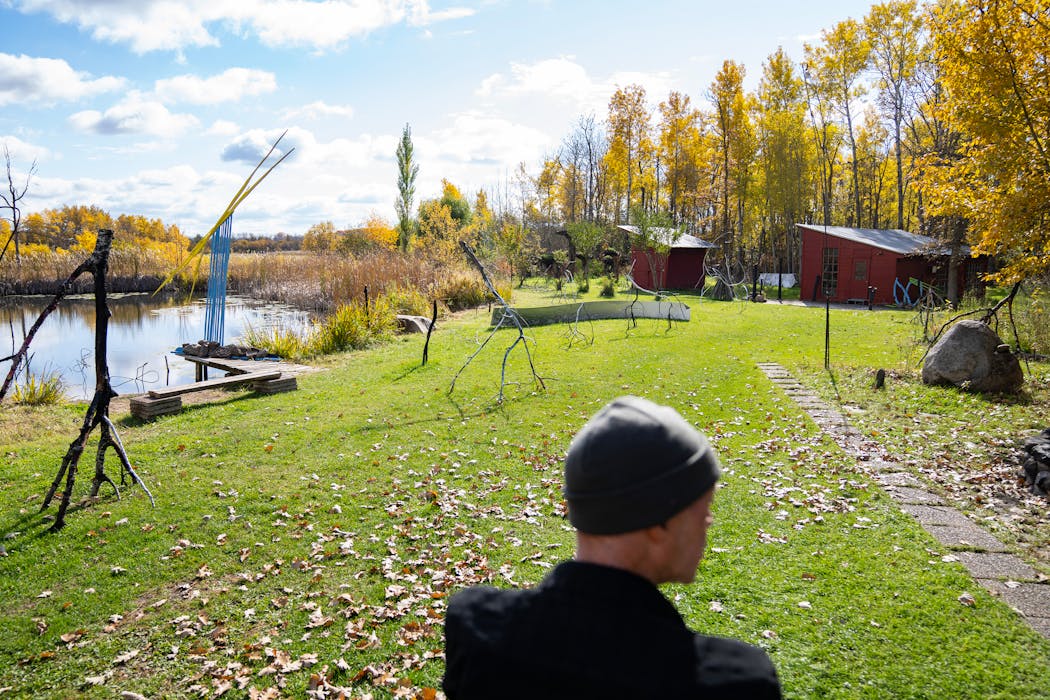Days before a recent retrospective of his work went on display, Russell Sharon picked up a hunk of crumpled aluminum from his living room table and declared it "the best sculpture I ever made."
The 70-something artist had been cutting the grass with his ride-on mower, he explained, when he heard a loud clang. A metal wash basin he'd run over popped out as a Duchamp-style readymade.
Most people don't have basins lying in their yard. But Russell Sharon isn't most people.
His farmstead, outside Little Falls, Minn., grows art as if it were crops. Wire "scribbles," as he calls them, outlining abstract human forms, stand sentinel on a hill. Painted branches, on their tiptoes, are scattered around the yard.
Just behind the studio stands Sharon's latest and most dramatic installation: a grove of upside-down trees. Their thick trunks spear the earth and dirt-clogged root balls replace a leafy canopy. The natural world — literally, jarringly — upended. "The degradation of nature really depresses me," Sharon said.
Nature has been Sharon's muse since he grew up in this very place. In the 1980s, he brought his abstract Midwestern landscapes to the avant-garde East Village art scene, running in the same circles as Jasper Johns and Keith Haring. Since then, his work has been spread far and wide, from installations enlivening the Miami Art Museum to paintings hanging on the walls of East Hampton collectors.
Now the local-boy-made-good has returned to Minnesota permanently, continuing to create, just off the radar of local art institutions.
Natural beginnings
Sharon, with his white hair and stubble, looks rather like a painting himself. His hands are covered with white and black paint. A few smudges of white grace his cheek and his neck. He gives a tour of his funky, paint-splattered home — his brother built the original structure for $400 — while palming a cigarette lighter.
Artwork is everywhere. A hunk of charred wood, pulled out of a fire, displayed on a table. Rows of abstract paintings lining the hallway. At his bedside, Sharon stows a chain-saw manual alongside a basket of handmade ceramic eggs. As he flips through a folder of his watercolors, out slips a snapshot of Johns, taken when Sharon visited him in St. Martin.
Growing up, Sharon walked across a pasture to his one-room schoolhouse and put on plays in his family's hayloft. He delighted in observing the shapes of trees, listening to birdsong, tromping through bogs to pick wild cranberries. He'd go outside during a rainstorm to absorb the thunder booms and lightning flashes. "I was deeply immersed in the elements of nature," he recalled. "I felt comfortable being alone in the forest, more comfortable than I did around people."
An inquisitive child, Sharon read Voltaire and Dostoevsky, aspiring to inhabit their characters' world of big ideas and emotions. So he went to study in Mexico City, where he met expatriates from all over the world. ("It was fun — we were hippies — I suppose it was rather decadent," Sharon recalled.)
A few years later, he moved to New York City with his partner, Luis Frangella, an Argentine painter. The East Village was emerging as the epicenter of experimental art, as artists and galleries moved into its dilapidated buildings.
Sharon's work caught the eye of the eponymous gallerist Hal Bromm, who had given Haring his first commercial gallery exhibition. Sharon showed impressionistic paintings of lakes and trees evoking rural Minnesota and a collection of "Chainsaw People," carved from trees on the farm ravaged by Dutch elm disease. (Sharon attributes his lifelong "love affair with wood" to his grandparents' sawmills, where he played in mountains of sawdust and learned to identify wood types by smell.)
Sharon worked across media. He made backdrops for nightclub stages and performances by Martha Graham's dance company, furniture for a quirky film set. He was energized by the tight-knit, high-octane group of artists who created as incessantly as they partied at their vodka-soaked exhibitions.
Then the AIDS epidemic arrived, to devastating effect. Sharon learned he was HIV-positive and was given two years to live. He defied the grim prognosis, but in 1990, lost Frangella to the disease. Sharon moved to Miami, but continued to spend summers in Minnesota, as he had for years, cultivating an arts community by hosting weekly portrait-drawing sessions. In the mid 2000s, he put his knack for portraiture to work creating 100 paintings of local people for the Great River Arts center in Little Falls.
Today, Sharon lives among kin and chosen family, with his brother and sister nearby along with several creative friends he recruited to the area, who refer to him as their "arty godfather."
Deep roots
"Inspiration energy is like jet fuel," Sharon said, as he walked through his studio filled with painted branches. Whether muscular oak or twisty willow, each expresses something different to Sharon: the strut of a runway model or a creepy three-legged spider. Inspiration struck, he said, when he turned a branch's stem upward and balanced it on its twigs. "You look at it, and there it is," he explained. "Nature did it on her own."
Sharon's upside-down trees were initially destined to become firewood for the bulldozer operator who agreed to take down the dying, centurion poplars. "But when the roots came out, that changed everything," he said. Instead of giving them up, Sharon had the trees cut at lengths of 10 to 12 feet and enlisted a friend with finely honed backhoe skills ("he could practically pull someone's tooth out with it") to replant them, trunk first.
With dandelions, crabapple saplings and grass blades springing from their root balls, the trees look very much alive, said Bromm, Sharon's longtime art dealer, after a visit to the farm. "It's such a simple idea, but we've never seen it before. It takes an artist's imagination — and particularly an artist who loves nature as Russell does — to take that tree that has sadly lost its life and turn it upside down and give it a whole new life."
Bromm envisions a stand of Sharon's upside-down trees in the Walker's Sculpture Garden, a nod to the artist's career having spanned urban and rural worlds. At this point in his life, Sharon plans to spend his twilight years planted amid the fresh air and starry skies. "As a young man, I wanted to leave the farm desperately," he said. "But I wanted to swing around and end my life here, do the complete cycle."
Russell Sharon's "Roots: a Retrospective" kicked off in October at his home in Randall, Minn. Showings are available by appointment. russellsharon.com

Summer Camp Guide: Find your best ones here

Lowertown St. Paul losing another restaurant as Dark Horse announces closing

Critics' picks: The 11 best things to hear, do and see in the Twin Cities this week

Critics' picks: The 9 best things to do and see in the Twin Cities this week




